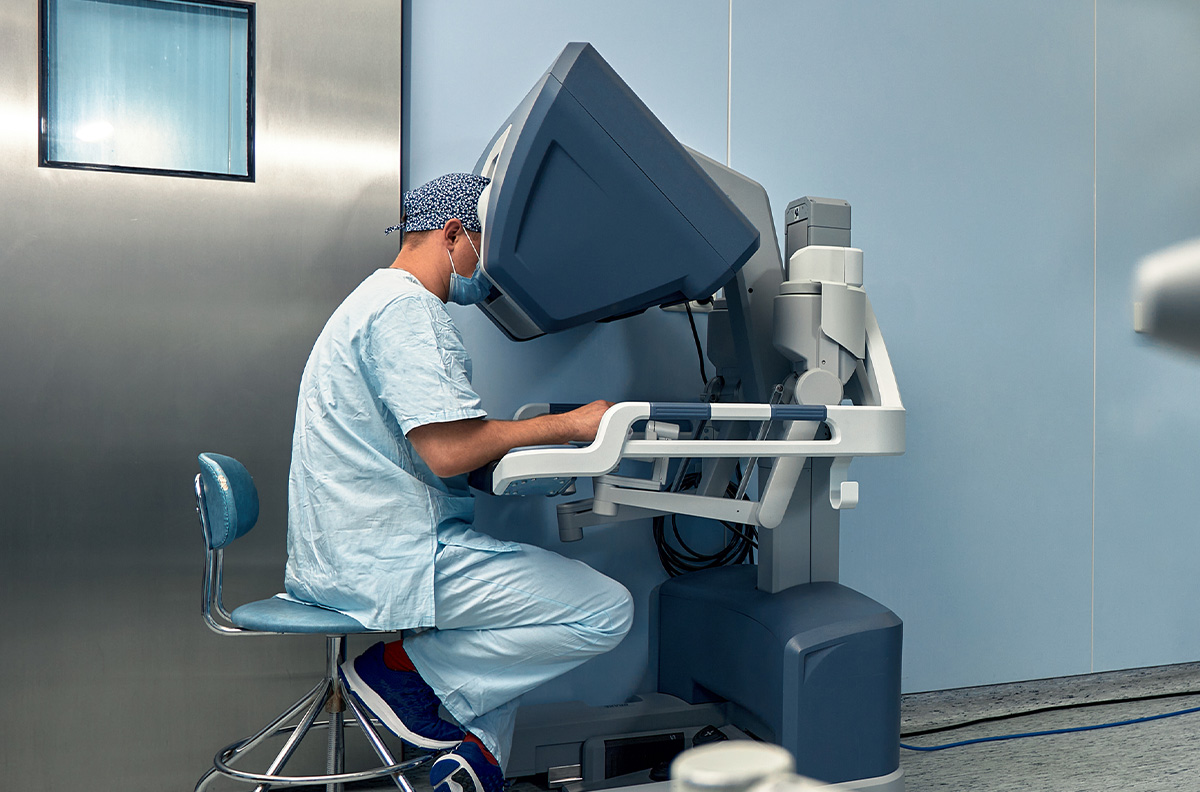Gastric Sleeve Surgery
Say goodbye to excess weight easily with gastric sleeve surgery. This procedure can also help you overcome diseases such as diabetes and high blood pressure.
Contents
Obesity can negatively impact human life in many ways, causing various health issues. Gastric sleeve surgery, also known as sleeve gastrectomy, is performed using laparoscopic techniques and significantly aids in weight loss by reducing stomach size, which consequently decreases the amount of food intake, allowing patients to experience weight loss.
Obesity increases the risk of developing diseases such as heart disease, high blood pressure, or diabetes; thus, losing excess weight can reduce the risk of these diseases and also speed up the recovery process for those already affected. Thus, gastric sleeve surgery not only addresses aesthetic concerns but also serious health issues. Research has shown that diseases such as sleep apnea can also improve following the surgery. Additionally, patients often feel psychologically better and regain lost self-confidence after surgery.
The success rate of the operation is exceedingly high. Regrets after gastric sleeve surgery are minimal when considering successful operations. Gastric sleeve surgery can be performed alone or in conjunction with other bariatric surgical treatment methods. Knowing what gastric sleeve surgery is can be the first step in your weight loss journey.
What is Gastric Sleeve Surgery?
Gastric sleeve surgery is a surgical procedure used in obesity treatment to effectively shed excess weight. In this method, known as sleeve gastrectomy, the stomach is transformed into a tube, much like the continuation of the esophagus, reducing its volume and altering its shape to that of a tube or banana. This change means the stomach no longer functions as a pouch but as an extension of the esophagus and intestines. Performed laparoscopically, a part of the stomach is removed during this procedure, which results in reduced food and calorie intake, expected to lead to weight loss. After gastric sleeve surgery, not only is the stomach size reduced, but hunger hormones are significantly suppressed, which further aids in weight loss.
This surgery is an effective method in the battle against obesity and helps prevent obesity-related health problems. However, patients must pay attention to their dietary habits and lifestyle changes after surgery. Obesity surgery is not suitable for every patient, so a comprehensive examination by a specialist doctor is necessary before deciding on gastric sleeve surgery, especially in cases of morbid obesity. Patient testimonials post-surgery can demonstrate the success of the operation.
Gastric sleeve surgery is often confused with gastric bypass, but they involve different procedures. In gastric sleeve surgery, a part of the stomach is completely removed, whereas in gastric bypass surgery, a small-volume stomach is created, and the consumed food bypasses the stomach, reaching the small intestine directly to promote weight loss.
How is Gastric Sleeve Surgery Performed?
Gastric sleeve surgery is now performed using a laparoscopic method rather than open surgery, which reduces both the duration of the procedure and the recovery time. Knowing how gastric sleeve surgery is performed can help alleviate any fears and concerns patients may have about the procedure. Although the exact steps can vary from patient to patient, the general procedure during gastric sleeve surgery typically involves:
- The patient is placed under general anesthesia,
- Small incisions are made in the abdomen, the number and size of which depend on the patient’s condition,
- Sometimes robotic devices are used, and because the incisions are very small, there is no significant aesthetic concern post-operation,
- To avoid excessive narrowing, a calibration tube is placed along the continuation of the esophagus, reducing the risk of stricture,
- Special tools are used to longitudinally remove a portion of the stomach,
- Once the calibration tube is removed, the surgeon ensures there is no bleeding or leakage before concluding the operation. Patients do not feel pain or discomfort during the surgery due to the general anesthesia. The question “How long does gastric sleeve surgery take?” can be answered as approximately 45 to 60 minutes, although preparation and awakening phases might extend this duration to about two hours.
Since the operation is performed laparoscopically, there are no cuts in the abdominal muscles or lining, which significantly reduces post-operative pain. Any abdominal pressure typically resolves on its own within a few days. Pain relievers may be prescribed if necessary. Patients can begin walking slowly on the evening of the surgery day.
Post-Gastric Sleeve Surgery Nutrition
(continued) and the part of the stomach that secretes the hunger hormone is removed. This results in patients feeling less hungry and becoming satiated more quickly with smaller amounts of food, which largely contributes to weight loss. However, it is crucial for patients to adhere to proper dietary habits post-surgery to ensure a healthy weight loss journey.
Each patient’s dietary program should be individually planned with the help of a dietitian. The transition from liquid to solid food takes approximately two months. The first month is restricted to entirely liquid and soft foods, with some solid foods gradually introduced in the diet after one month. By the second month, patients can slowly start returning to a more normal diet. Key dietary considerations for patients include:
- Initially focus on consuming liquids rich in vitamins and proteins, particularly B12,
- Avoid fatty and high-calorie foods,
- Start with non-textured liquids for the first and second weeks, followed by pureed foods in the second and third weeks, then gradually introduce solid foods,
- Eat small amounts frequently,
- Chew food thoroughly and eat slowly,
- Avoid extremely hot or cold foods.
Following these guidelines can help maintain the success of the surgery and contribute to effective weight loss.
Restrictions After Gastric Sleeve
Surgery Post-operative restrictions for patients primarily concern dietary habits. Not adhering to these can lead to increased risks and reduce the effectiveness of the surgery. For optimal results and to see the effects of the surgery quickly, patients should adhere to the following restrictions:
- Avoid high-carbohydrate or sugary foods and beverages,
- Stay away from caffeinated or acidic drinks as they can cause bloating or discomfort,
- Limit alcohol consumption as it can negatively impact weight control,
- Avoid spicy and acidic foods to prevent gastric irritation,
- Stay clear of hard-to-digest, heavy, or fatty foods,
- Do not consume excessive liquids during meals; plan liquid intake before and after meals instead,
- Avoid taking any supplements or medications not prescribed by a doctor.
Additionally, patients should avoid heavy physical activities and sexual intercourse for the first two months post-surgery and should not drive for one month. The use of a corset after gastric sleeve surgery is generally not required unless advised by a doctor.
Long-term compliance with these dietary and lifestyle changes significantly reduces the likelihood of obesity reoccurrence. The more diligently patients follow these rules, the more weight they can lose.
Risks of Gastric Sleeve Surgery
While gastric sleeve surgery is performed using laparoscopic techniques and carries fewer risks than open surgeries, like all surgical procedures, it can have potential complications, albeit rarely. Complications can include:
- Excessive bleeding or blood clotting,
- Infection,
- Complications from general anesthesia,
- Respiratory issues related to complications in the lungs,
- Intestinal blockage,
- Gallstone formation.
Additional, rarer issues post-surgery can include vomiting, ulcers, hernias, diarrhea, acid reflux, nutritional deficiencies, and hypoglycemia. However, these complications are very rare, and choosing an experienced surgeon can minimize these risks significantly.
Symptoms of Leakage After Gastric Sleeve Surgery
After the gastric sleeve surgery, when a part of the stomach is removed, the remaining section is stitched or stapled. If these stitched or stapled sections begin to leak, stomach acid and even stomach contents can seep into the abdominal cavity. Leakage symptoms typically appear between the 5th and 8th days post-surgery. If no leakage has occurred by day 10, it is unlikely to develop at a later stage.
Common symptoms of leakage include nausea, fever, respiratory problems, and abdominal pain. These symptoms may appear alone or in combination. Although leakage is not typically an emergency, it is crucial to consult a doctor without delay if these symptoms occur. Following diagnostic tests, if leakage is confirmed, it can be addressed with a second surgery or non-surgical methods, depending on the case. However, once addressed, the recurrence of leakage is usually not a concern.
Costs of Gastric Sleeve Surgery
The costs of gastric sleeve surgery can vary significantly from one individual to another, as each person’s general health condition, body structure, and expectations differ. Factors influencing the cost include the city, choice of surgeon, and surgical techniques used. Therefore, it is essential for the surgeon to conduct a comprehensive evaluation before providing a cost estimate. This evaluation will inform the patient about how the surgery should be performed and provide an estimate of the costs involved.
Gastric sleeve surgery can significantly impact a person’s life, thus the choice of surgeon is crucial. It is vital for patients considering this surgery to entrust their care to an experienced and specialized surgeon. Inadequate care can lead to severe complications that may even threaten the patient’s life. If you want to learn more about gastric sleeve surgery procedures or to schedule a comprehensive examination, feel free to contact us now.







